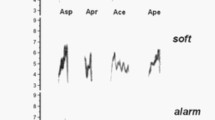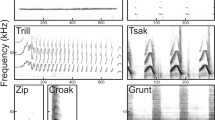Abstract
The cat family Felidae is one of the most successful carnivore lineages today. However, the study of acoustic communication between felids remains a challenge due to the lack of fossils, the limited availability of audio recordings because of their largely solitary and secretive behaviour, and the underdevelopment of computational models and methods needed to address these questions. This study attempts to develop a machine learning-based approach which can be used to identify acoustic features that distinguish felid call types and species from one another through the optimization of classification tasks on these call types and species. A felid call dataset was developed by extracting audio clips from diverse sources. Due to the limited availability of samples, this study focused on the Pantherinae subfamily. The audio clips were manually annotated for call type and species. Time–frequency features were then extracted from the dataset. Finally, several multi-class classification algorithms were applied to the resulting data for classifying species and call types. We found that duration, mean mel spectrogram, frequency range, and amplitude range were among the most distinguishing features for the classifications.








Similar content being viewed by others
Data availability
The data that support the findings of this study are available on request from the corresponding author, DB. The data are not publicly available due to copyright limitations.
References
Balemarthy, S., Sajjanhar, A., Zheng, J.X.: Our practice of using machine learning to recognize species by voice. arXiv:1810.09078 (2018).
Chen, Z., Wiens, J.J.: The origins of acoustic communication in vertebrates. Nat. Commun. 11, 369 (2020). https://doi.org/10.1038/s41467-020-14356-3
Davis, S.B., Mermelstein, P.: Comparison of parametric representation for monosyllabic word recognition in continuously spoken sentences. IEEE Trans. ASSP 28, 357–366 (1980)
Ehret, G.: Development of Sound communication in mammals. Adv. Study Behav. 11, 179–225 (1980). https://doi.org/10.1016/S0065-3454(08)60118-7
Ferdiana, R., Dicka, W.F., Boediman, A.: Cat sounds classification with convolutional neural network. Int. J. Electric. Eng. Inf. 13(3), 755–765 (2021)
Figueiró, H.V., et al.: Genome-wide signatures of complex introgression and adaptive evolution in the big cats. Sci. Adv. 3, e1700299 (2017)
Gunasekaran, S., Revathy, K.: Content-based classification and retrieval of wild animal sounds using feature selection algorithm. In: 2010 Second International Conference on Machine Learning and Computing, pp. 272–275. IEEE (2010)
Hauser, M.D.: The Evolution of Communication. The MIT Press, New York (1996)
Ji, A., Johnson, M.T., Walsh, E.J., McGee, J., Armstrong, D.L.: Discrimination of individual tigers (Panthera tigris) from long distance roars. J. Acoust. Soc. Am. 133(3), 1762–1769 (2013)
Johnson et al.: The late miocene radiation of modern felidae: A Genetic Assessment. Science 311: 73–78 (2006). Kitchener, A.: The Natural History of the Wild Cats. A & C Black, London (1991)
Kitchener, A.C., Breitenmoser-Würsten, Ch., Eizirik, E., Gentry, A., Werdelin, L., Wilting, A., Yamaguchi, N., Abramov, A.V., Christiansen, P., Driscoll, C., Duckworth, J.W., Johnson, W., Luo, S.-J., Meijaard, E., O’Donoghue, P., Sanderson, J., Seymour, K., Bruford, M., Groves, C., Hoffmann, M., Nowell, K., Timmons, Z., Tobe, S.: A revised taxonomy of the Felidae. The final report of the Cat Classification Task Force of the IUCN/SSC Cat Specialist Group. Cat News Special Issue 11 (2017)
Kukushkin, M., Ntalampiras, S.: Automatic acoustic classification of feline sex. In: Audio Mostly 2021, pp. 156–160 (2021)
Lee, C.H., Chou, C.H., Han, C.C., Huang, R.Z.: Automatic recognition of animal vocalizations using averaged MFCC and linear discriminant analysis. Patt. Recogn. Lett. 27(2), 93–101 (2006)
Nanni, L., Maguolo, G., Paci, M.: Data augmentation approaches for improving animal audio classification. Eco. Inform. 57, 101084 (2020)
Nanni, L., Brahnam, S., Lumini, A., Maguolo, G.: Animal sound classification using dissimilarity spaces. Appl. Sci. 10(23), 8578 (2020)
Nanni, L., Maguolo, G., Brahnam, S., Paci, M.: An ensemble of convolutional neural networks for audio classification. Appl. Sci. 11(13), 5796 (2021). https://doi.org/10.3390/app11135796
Ntalampiras, S., Ludovico, L.A., Presti, G., Prato Previde, E., Battini, M., Cannas, S., et al.: Automatic classification of cat vocalizations emitted in different contexts. Animals 9(8), 543 (2019)
Ntalampiras, S., Kosmin, D., Sanchez, J.: Acoustic classification of individual cat vocalizations in evolving environments. In: 2021 44th International Conference on Telecommunications and Signal Processing (TSP), Brno, Czech Republic, pp. 254–258 (2021). https://doi.org/10.1109/TSP52935.2021.9522660
Pandeya, Y.R., Lee, J.: Domestic cat sound classification using transfer learning. Int. J. Fuzzy Logic Intell. Syst. 18(2), 154–160 (2018)
Pandeya, Y.R., Kim, D., Lee, J.: Domestic cat sound classification using learned features from deep neural nets. Appl. Sci. 8(10), 1949 (2018)
Pecon-Slattery, et al.: Phylogenetic assessment of introns and sines within the Y chromosome using the cat family felidae as a species tree mol. Biol. Evol. 21, 22299–22309 (2004)
Peters, G., Peters, M.K.: Long-distance call evolution in the Felidae: effects of body weight, habitat, and phylogeny. Biol. J. Lin. Soc. 101(2), 487–500 (2010). https://doi.org/10.1111/j.1095-8312.2010.01520.x
Peters, G.: Vocal communication in cats. In: Great Cats, pp. 76–77 (1991)
Peters, G.: Vergleichende Untersuchung zur Lautgebung einiger Feliden (Mammalia, Felidae), Vol. 1 of Spixiana, pp. 1–283 (1978)
Peters, G., Tonkin-Leyhausen, B.A.: Evolution of acoustic communication signals of mammals: friendly close range vocalizations in Felidae (Carnivora). J. Mamm. Evol. 6(2), 129–159 (1999)
Raccagni, W., Ntalampiras, S.: Acoustic classification of cat breed based on time and frequency domain features. In: 2021 30th Conference of Open Innovations Association FRUCT, pp. 184–189. IEEE (2021)
Rana, D., Jain, A.: Effect of windowing on the calculation of MFCC statistical parameter for different gender in hindi speech. Int. J. Comput. Appl. 98(8), 6–10 (2014). https://doi.org/10.5120/17201-7409
Sunquist, M., Sunquist, F.: Wild Cats of the World. University of Chicago Press, Chicago (2002) ISBN 0-226-77999-8
Suzuki, Y., Osawa, A.: Identifying individual cats by their chewing sounds using deep learning. In: Stephanidis, C., Antona, M., Ntoa, S. (eds) HCI International 2021—Posters. HCII 2021. Communications in Computer and Information Science, Vol. 1420. Springer, Cham (2021). . https://doi.org/10.1007/978-3-030-78642-7_74
Tavernier, C., Ahmed, S., Houpt, K.A., Yeon, S.C.: Feline vocal communication. J Vet Sci. 21(1), 18 (2020). https://doi.org/10.4142/jvs.2020.21.e18
Trapanotto, M., Nanni, L., Brahnam, S., Guo, X.: Convolutional neural networks for the identification of african lions from individual vocalizations. J. Imaging 8(4), 96 (2022). https://doi.org/10.3390/jimaging8040096
Weninger, F., Schuller, B. (2011). Audio recognition in the wild: Static and dynamic classification on a real-world database of animal vocalizations. In: 2011 IEEE International Conference on Acoustics, Speech and Signal Processing (ICASSP), pp 337–340. IEEE.
Wu, X., Zhou, S., Chen, M., Zhao, Y., Wang, Y., Zhao, X., et al.: Combined spectral and speech features for pig speech recognition. PLoS ONE 17(12), e0276778 (2022)
Acknowledgements
The authors would like to acknowledge the contributions by: Sai Greeshma Saladi, Rohindraj Kandasamy, Nicholas Furey, Tianyu Yang to the data preprocessing and Brendan Smith, Rebecca Buonopane for assisting in audio annotations. We are grateful for the audio files provided by Dr. Gustav Peters, former Curator of Mammals, Zoological Research Museum, Bonn, and Dr. Karl-Heinz Frommolt, Scientific Head of the Animal Sound Archive (Museum für Naturkunde Berlin). We would also like to thank the anonymous reviewers for their helpful comments that helped to improve this paper.
Funding
This work was supported by the Fairfield University Science Institute (AB and MP), the Fredrickson Family Innovation Lab Grant (AB and MP), Fairfield University Computer Science Start-up grant (DB), and Georgia State University Computer Science Start-up Grant (MP).
Author information
Authors and Affiliations
Corresponding author
Ethics declarations
Conflict of interest
The authors report there are no competing interests to declare.
Additional information
Publisher's Note
Springer Nature remains neutral with regard to jurisdictional claims in published maps and institutional affiliations.
Rights and permissions
Springer Nature or its licensor (e.g. a society or other partner) holds exclusive rights to this article under a publishing agreement with the author(s) or other rightsholder(s); author self-archiving of the accepted manuscript version of this article is solely governed by the terms of such publishing agreement and applicable law.
About this article
Cite this article
Bandara, D., Exantus, K., Navarro-Martinez, C. et al. Identifying Distinguishing Acoustic Features in Felid Vocalizations Based on Call Type and Species Classification. Acoust Aust 51, 345–357 (2023). https://doi.org/10.1007/s40857-023-00298-5
Received:
Accepted:
Published:
Issue Date:
DOI: https://doi.org/10.1007/s40857-023-00298-5




